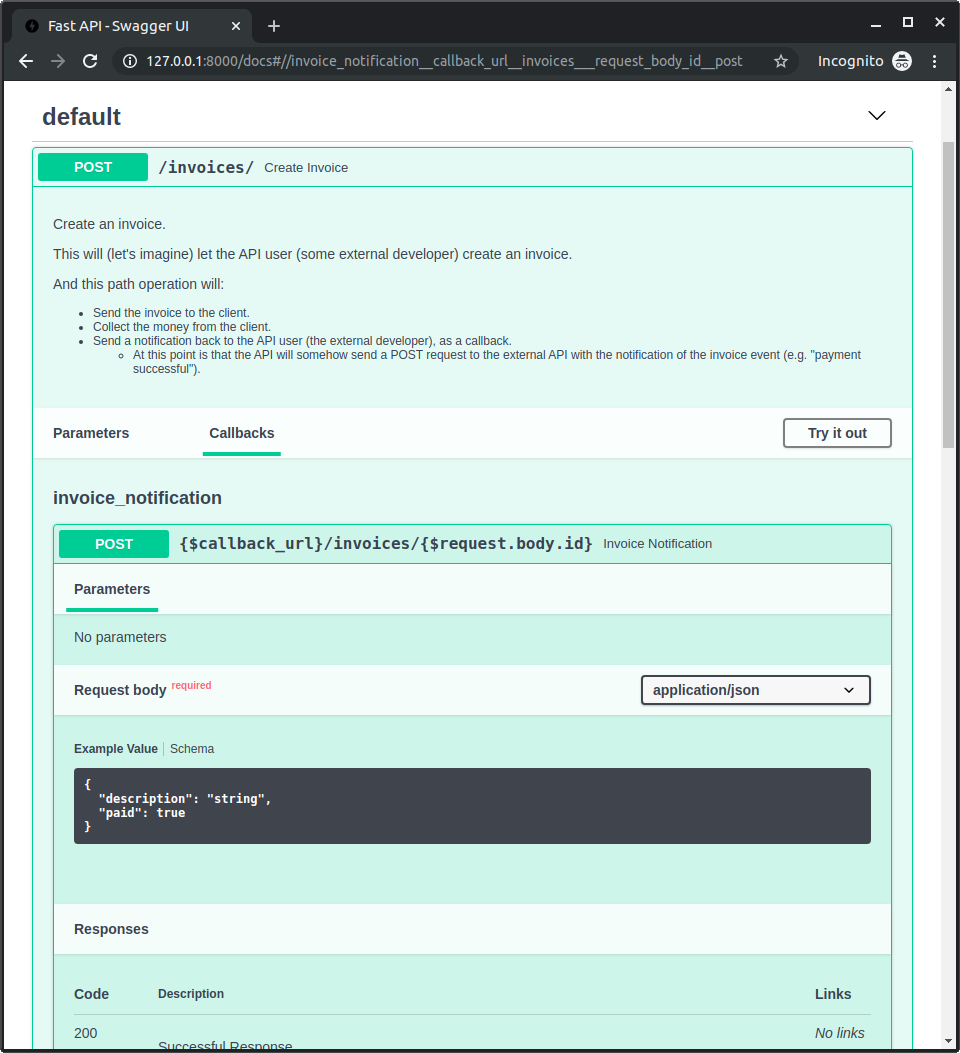OpenAPI 回呼¶
您可以建立一個帶有「路徑操作」的 API,該操作可以觸發對其他人(可能是與使用您的 API 的開發者相同)建立的「外部 API」的請求。
當您的 API 應用程式呼叫「外部 API」時發生的過程稱為「回呼」。因為外部開發人員編寫的軟體會向您的 API 發送請求,然後您的 API 會「回呼」,向「外部 API」(可能是由同一位開發人員建立的)發送請求。
在這種情況下,您可能想要記錄該外部 API 應該是什麼樣子的。它應該有什麼「路徑操作」、應該接受什麼主體、應該返回什麼響應等等。
具有回呼的應用程式¶
讓我們用一個例子來看這一切。
假設您開發了一個允許建立發票的應用程式。
這些發票將具有 id、title(可選)、customer 和 total。
您的 API 使用者(外部開發人員)將使用 POST 請求在您的 API 中建立發票。
然後您的 API 將(讓我們想像一下)
- 將發票發送給外部開發人員的某些客戶。
- 收款。
- 將通知發送回 API 使用者(外部開發人員)。
- 這將透過向該外部開發人員提供的某些「外部 API」發送 POST 請求(從您的 API)來完成(這就是「回呼」)。
一般的 FastAPI 應用程式¶
讓我們先看看在新增回呼之前,一般的 API 應用程式是什麼樣子的。
它將有一個「路徑操作」,該操作將接收 Invoice 主體和一個包含回呼 URL 的查詢參數 callback_url。
這部分很正常,大部分程式碼您可能已經很熟悉了
from typing import Union
from fastapi import APIRouter, FastAPI
from pydantic import BaseModel, HttpUrl
app = FastAPI()
class Invoice(BaseModel):
id: str
title: Union[str, None] = None
customer: str
total: float
class InvoiceEvent(BaseModel):
description: str
paid: bool
class InvoiceEventReceived(BaseModel):
ok: bool
invoices_callback_router = APIRouter()
@invoices_callback_router.post(
"{$callback_url}/invoices/{$request.body.id}", response_model=InvoiceEventReceived
)
def invoice_notification(body: InvoiceEvent):
pass
@app.post("/invoices/", callbacks=invoices_callback_router.routes)
def create_invoice(invoice: Invoice, callback_url: Union[HttpUrl, None] = None):
"""
Create an invoice.
This will (let's imagine) let the API user (some external developer) create an
invoice.
And this path operation will:
* Send the invoice to the client.
* Collect the money from the client.
* Send a notification back to the API user (the external developer), as a callback.
* At this point is that the API will somehow send a POST request to the
external API with the notification of the invoice event
(e.g. "payment successful").
"""
# Send the invoice, collect the money, send the notification (the callback)
return {"msg": "Invoice received"}
提示
callback_url 查詢參數使用 Pydantic Url 類型。
唯一新的東西是作為「路徑操作裝飾器」參數的 callbacks=invoices_callback_router.routes。我們接下來會看到那是什麼。
記錄回呼¶
實際的回呼程式碼將很大程度上取決於您自己的 API 應用程式。
而且它可能會因應用程式而異。
它可能只是一兩行程式碼,例如
callback_url = "https://example.com/api/v1/invoices/events/"
httpx.post(callback_url, json={"description": "Invoice paid", "paid": True})
但回呼中最重要的部分可能是確保您的 API 使用者(外部開發人員)根據您的 API 將在回呼的請求主體中發送的資料等正確地實作「外部 API」。
因此,我們接下來要做的是新增程式碼來記錄該「外部 API」應該是什麼樣子,以便從您的 API 接收回呼。
該文件將顯示在您 API 中 /docs 的 Swagger UI 中,它將讓外部開發人員知道如何建置「外部 API」。
此範例沒有實作回呼本身(那可能只是一行程式碼),只有文件部分。
編寫回呼函數的文件程式碼¶
這段程式碼不會在您的應用程式中執行,我們只需要它來*記錄*該*外部 API* 應該是什麼樣子。
但是,您已經知道如何使用 FastAPI 輕鬆地為 API 建立自動文件。
因此,我們將使用相同的知識來記錄*外部 API* 應該是什麼樣子...方法是建立外部 API 應該實作的*路徑操作*(您的 API 將呼叫的操作)。
提示
在編寫程式碼以記錄回呼函數時,想像您是該*外部開發人員*可能會有幫助。並且您目前正在實作*外部 API*,而不是*您的 API*。
暫時採用這種*外部開發人員*的觀點可以幫助您更清楚地了解在哪裡放置參數、主體的 Pydantic 模型、響應等等,以便用於該*外部 API*。
建立回呼函數 APIRouter¶
首先建立一個新的 APIRouter,其中將包含一個或多個回呼函數。
from typing import Union
from fastapi import APIRouter, FastAPI
from pydantic import BaseModel, HttpUrl
app = FastAPI()
class Invoice(BaseModel):
id: str
title: Union[str, None] = None
customer: str
total: float
class InvoiceEvent(BaseModel):
description: str
paid: bool
class InvoiceEventReceived(BaseModel):
ok: bool
invoices_callback_router = APIRouter()
@invoices_callback_router.post(
"{$callback_url}/invoices/{$request.body.id}", response_model=InvoiceEventReceived
)
def invoice_notification(body: InvoiceEvent):
pass
@app.post("/invoices/", callbacks=invoices_callback_router.routes)
def create_invoice(invoice: Invoice, callback_url: Union[HttpUrl, None] = None):
"""
Create an invoice.
This will (let's imagine) let the API user (some external developer) create an
invoice.
And this path operation will:
* Send the invoice to the client.
* Collect the money from the client.
* Send a notification back to the API user (the external developer), as a callback.
* At this point is that the API will somehow send a POST request to the
external API with the notification of the invoice event
(e.g. "payment successful").
"""
# Send the invoice, collect the money, send the notification (the callback)
return {"msg": "Invoice received"}
建立回呼函數*路徑操作*¶
要建立回呼函數*路徑操作*,請使用您上面建立的相同 APIRouter。
它看起來應該像普通的 FastAPI *路徑操作*
- 它應該包含它應該接收的主體的宣告,例如
body: InvoiceEvent。 - 它還可以包含它應該返回的響應的宣告,例如
response_model=InvoiceEventReceived。
from typing import Union
from fastapi import APIRouter, FastAPI
from pydantic import BaseModel, HttpUrl
app = FastAPI()
class Invoice(BaseModel):
id: str
title: Union[str, None] = None
customer: str
total: float
class InvoiceEvent(BaseModel):
description: str
paid: bool
class InvoiceEventReceived(BaseModel):
ok: bool
invoices_callback_router = APIRouter()
@invoices_callback_router.post(
"{$callback_url}/invoices/{$request.body.id}", response_model=InvoiceEventReceived
)
def invoice_notification(body: InvoiceEvent):
pass
@app.post("/invoices/", callbacks=invoices_callback_router.routes)
def create_invoice(invoice: Invoice, callback_url: Union[HttpUrl, None] = None):
"""
Create an invoice.
This will (let's imagine) let the API user (some external developer) create an
invoice.
And this path operation will:
* Send the invoice to the client.
* Collect the money from the client.
* Send a notification back to the API user (the external developer), as a callback.
* At this point is that the API will somehow send a POST request to the
external API with the notification of the invoice event
(e.g. "payment successful").
"""
# Send the invoice, collect the money, send the notification (the callback)
return {"msg": "Invoice received"}
與正常的*路徑操作*有 2 個主要區別
- 它不需要有任何實際的程式碼,因為您的應用程式永遠不會呼叫此程式碼。它僅用於記錄*外部 API*。因此,該函數可以只有
pass。 - *路徑*可以包含 OpenAPI 3 表達式(請參閱下文),其中可以使用帶有參數的變數和發送到*您的 API* 的原始請求的部分內容。
回呼函數路徑表達式¶
回呼函數*路徑*可以包含一個 OpenAPI 3 表達式,其中可以包含發送到*您的 API* 的原始請求的部分內容。
在這種情況下,它是 str
"{$callback_url}/invoices/{$request.body.id}"
因此,如果您的 API 使用者(外部開發人員)向*您的 API* 發送請求至
https://yourapi.com/invoices/?callback_url=https://www.external.org/events
具有以下 JSON 主體
{
"id": "2expen51ve",
"customer": "Mr. Richie Rich",
"total": "9999"
}
那麼*您的 API* 將處理發票,並在稍後某個時間點,將回呼函數請求發送到 callback_url(*外部 API*)
https://www.external.org/events/invoices/2expen51ve
具有包含如下內容的 JSON 主體
{
"description": "Payment celebration",
"paid": true
}
並且它預期來自該*外部 API* 的響應,其 JSON 主體如下
{
"ok": true
}
提示
請注意,所使用的回呼函數 URL 如何包含在 callback_url 中作為查詢參數接收的 URL(https://www.external.org/events)以及 JSON 主體內部的發票 id(2expen51ve)。
新增回呼函數路由器¶
此時,您已在上面建立的回呼函數路由器中擁有所需的*回呼函數路徑操作*(*外部開發人員*應該在*外部 API* 中實作的操作)。
現在,使用*您的 API 的路徑操作裝飾器*中的參數 callbacks 來傳遞來自該回呼函數路由器的屬性 .routes(實際上只是路由/*路徑操作*的list)
from typing import Union
from fastapi import APIRouter, FastAPI
from pydantic import BaseModel, HttpUrl
app = FastAPI()
class Invoice(BaseModel):
id: str
title: Union[str, None] = None
customer: str
total: float
class InvoiceEvent(BaseModel):
description: str
paid: bool
class InvoiceEventReceived(BaseModel):
ok: bool
invoices_callback_router = APIRouter()
@invoices_callback_router.post(
"{$callback_url}/invoices/{$request.body.id}", response_model=InvoiceEventReceived
)
def invoice_notification(body: InvoiceEvent):
pass
@app.post("/invoices/", callbacks=invoices_callback_router.routes)
def create_invoice(invoice: Invoice, callback_url: Union[HttpUrl, None] = None):
"""
Create an invoice.
This will (let's imagine) let the API user (some external developer) create an
invoice.
And this path operation will:
* Send the invoice to the client.
* Collect the money from the client.
* Send a notification back to the API user (the external developer), as a callback.
* At this point is that the API will somehow send a POST request to the
external API with the notification of the invoice event
(e.g. "payment successful").
"""
# Send the invoice, collect the money, send the notification (the callback)
return {"msg": "Invoice received"}
提示
請注意,您傳遞給 callback= 的不是路由器本身 (invoices_callback_router),而是它的屬性 .routes,如 invoices_callback_router.routes。
查看文件¶
現在您可以啟動您的應用程式並前往 http://127.0.0.1:8000/docs。
您將會看到您的文件,其中包含一個針對您的*路徑操作*的「回呼」區段,顯示*外部 API* 應該呈現的樣子。
